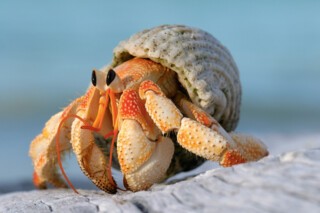It was, perhaps, a hermit crab that ate Amelia Earhart. For five nights after Earhart disappeared from the sky in 1937, the US navy picked up distress signals from Nikumaroro, an uninhabited island in the Western Pacific. When a rescue team reached the island a week later – it took time, since planes had to be loaded onto battleships – it was deserted. But researchers on the island have since discovered human bones matching Earhart’s size: another, later team discovered the shattered glass of a woman’s compact mirror and a few flakes of rouge. The bones were sent to be tested, but were lost on the way, and unless they are found we won’t ever be sure whether they belonged to the valiant, hell-for-leather aviatrix with the face of a lion. But, if the bones were Earhart’s, only 13 were found, and the human body has 206: where were the other 193?
Crunched, perhaps, to fragments. Nikumaroro is home to a colony of coconut hermit crabs: the world’s largest land crab, so called because of its ability to crack open a coconut, manoeuvring a claw into one of the nut’s three eyeholes and prying it open. The oldest live to more than a hundred, and grow to be wider than three feet across: too large to fit in a bathtub, exactly the right size for a nightmare. In 2007, researchers decided to test the Earhart theory. The carcass of a small pig was offered to the crabs on the island, to see what they might have done to Earhart’s dead or dying body. Following their remarkable sense of smell, they found the pig and tore it apart, making off with its bones to their burrows under the roots of the trees. Their strength is monumental: their claw grip can produce up to 3300 newtons of force (the bite force of a tiger is 1500 newtons). Darwin called them ‘monstrous’: he meant it as a compliment.
Even monsters, though, start small. Some hermit crabs inhabit the land and others the sea, but they all begin microscopic and underwater. They’re released as eggs into the ocean, hatch as unprepossessing larvae (though what larvae are prepossessing?) and it’s only after several months that they are large enough to inhabit the smallest empty shell they can find. As they grow, they graduate from one scavenged shell to another, most frequently the delicately sworled shell of a sea snail, grasping its columella with claspers at the tip of their abdomen. They shed their exoskeletons, releasing into the sea a semi- transparent floating crab – a ghost. The coconut crab eventually outgrows all other shells, and begins to live uncovered on the land, but the majority of the 1100-odd species of hermit crabs live in borrowed homes all their lives.
Hermit crabs are not, in fact, hermitical: they’re sociable, often climbing on top of one another to sleep in great piles, and their group behaviour is so intricately ordered that they make the politics of Renaissance courts look simplistic. When a crab comes across a new shell, it will climb into it and try it on for size. If the shell is of good quality but too big, it waits nearby for another crab to come and inspect it. If that crab also finds it too large, it joins the first crab, holding onto its claw until a queue develops – it can stretch to twenty crabs, arranged in order of size from smallest to largest, each holding onto the next: a hermit crab chorus line. When at last a crab arrives who can fit the vacant shell, the first crab in line claims the new crab’s former shell, and there is a flurry of crabs climbing into their neighbour’s home. The crab’s abdomen is soft and vulnerable to attack while exposed, so the whole process takes place with astonishing rapidity.
They’re not only foragers for homes: some are renovators. The anemone hermit crab is so called because it lifts anemones from the seabed and sticks them to its shell, where their stinging tentacles offer protection and disguise from predatory octopuses. The anemone, in symbiotic turn, consumes scraps of the hermit’s food as they float by. When the time comes to move to a larger shell, the crab, with some difficulty and great persistence, prises her anemones off the old shell and fixes them to the new.
Because they are small, and because their eyes on stalks, their ommatophores, are curious and gentle, the Caribbean and Ecuadorian hermit crabs are often sold as easy-care pets. Salesmen paint their shells in bright colours, which slowly poisons them. Many, needing dense humidity to breathe, suffocate in their tanks. On the beaches, they are trapped and killed by plastic. Nor are they safe in the sea: some live at depths of more than 6600 feet, and our pollution reaches them even there. The coconut crab, one of the rarest hermit crabs, risks extinction in large part because its flesh is believed to be an aphrodisiac. In this faith, as with tiger claws and rhino horn, there is evidence of great human vulnerability, and enough stupidity to destroy entire ecosystems. In fact, the sum total of natural aphrodisiacs – non-medical sexual stimulants – is zero. Historically, we’ve chosen to believe there are aphrodisiacal powers in a) that which is rare, exotic, new or expensive or b) in food laden with spice, which speeds the metabolism and sparks heat within the body or c) food which looks like a penis or a vagina or d) food which actually is a penis or vagina, or eggs or similar. Oysters, for instance, are made up largely of water, protein, salt, zinc, iron and tiny amounts of calcium and potassium: they’re no more an aphrodisiac than a vitamin pill drowned in salt water, but they look suggestive. We have in the past given sexual potency, haphazardly, to chocolate, asparagus, carrots, honey, nettles, mustard and sparrows. For Shakespeare, the potato was rare and exotic, and generally believed to have aphrodisiac qualities: ‘Let the sky rain potatoes,’ Falstaff says in The Merry Wives of Windsor, ‘let it thunder to the tune of Green Sleeves, hail kissing-comfits and snow eringoes; let there come a tempest of provocation.’ If we could all go back to that, back to the potato, how much would be saved.
The majority of hermit crabs are asymmetrical; they have ten legs, but the front left claw is enlarged for defence, and the front right is smaller, for scooping food, about which they aren’t fussy: algae, plant life, other dead crabs. They have, too, under their shells, rear ends that twist in on themselves – helter-skelters. And they’re off-kilter beautiful: the jewelled anemone crab has shocking emerald eyes, on stalks that are striped like a barber’s pole in red and white. They can be sea-grey or royal purple; the giant spotted hermit crab is orange with white dots edged in black; the hairy yellow is striped yellow and cream, with opulent hairs on its legs and eyes on blue stalks. Up close, even the coconut crabs are beautiful: some are aquamarine at the hinges, some rich brown with a burnt-orange back.
Hermit crabs can, if they must, make their home almost anywhere. They have been found in tin cans, in coconut halves. The Pylochelidae family evolved to make their homes not in shells but in sea-sponges, stones, driftwood, pieces of bamboo. More and more, in these darker days, I admire resourcefulness. I love their tenacity: forging lives from the shells of the dead, making homes from the debris that the world, in its chaos, has left out for them.
Send Letters To:
The Editor
London Review of Books,
28 Little Russell Street
London, WC1A 2HN
letters@lrb.co.uk
Please include name, address, and a telephone number.


